In this review I am going to try and figure out if the words “streamlining” and “compromising” are inevitable synonyms of one another.
As somebody who generally dislikes survival games, I found the first Subnautica to be a very refreshing departure from genre norms. It almost exclusively focused on the exploration of underwater environments with technologically-advanced equipment, as opposed to having me punch trees to get wood to make a stone axe for the five millionth time; and it also took the unusual decision to have that underwater environment be built by hand instead of procedurally generated, which gave the game some much-needed structure and let it tell a story. The way new technology unlocked the ability to survive in ever-deeper areas reminded me quite pleasantly of Metroid, and while the actual survival mechanics in game (food and water meters that slowly tick down) were totally bog-standard and uninteresting to manage, in terms of the exploration Subnautica did at least grasp a core tenet of the genre that I feel a lot of survival games miss: once mastery of a thing has been displayed the game should offer tools to make doing that thing much much easier — or even automate it away entirely — while introducing new challenges for the player to deal with. There is an excellent sense of progression through Subnautica, which is important because the existence of progression implies that you’re actually going somewhere. Subnautica bucks genre expectations yet again by actually having an ending to its story, and one which you won’t have to put dozens of hours into the game in order to see — I completed it in just over twenty hours, which is the perfect length for the sort of game Subnautica is.
So Subnautica already struck me as quite a streamlined, polished survival game. This was to be expected, as it had had the benefit of over two years in early access when I got around to playing it. However, what I particularly liked about Subnautica was that it still had just enough sharp edges to give it some bite. I have vivid memories of getting lost in maze-like wrecks while my oxygen counter slowly ticked down and I frantically searched for the way out; of taking the Cyclops a little too far down into an ocean trench in an attempt to evade angry wildlife and having the structural integrity start to fail, which led to a panicked dash around the ship to patch up all the leaks before the interior compartments flooded; and of gazing into the cavernous maw of a Reaper Leviathan as it attempted to devour my Sea Moth with me still inside it — fortunately I had the presence of mind to abandon ship and skim away on my Seaglide while it was preoccupied with the larger craft. Compared to the rest of the survival genre Subnautica is quite a nice and friendly game, but it still won’t hesitate to kill you if you get overconfident or let your guard down. Venturing into the inky blackness of the deep ocean isn’t particularly scary if there’s no risk to it, and this is something that Subnautica very much understood.
Really, I can’t recommend the original Subnautica enough. This, however, is not a review of the original Subnautica. This is a review of the recently-released Subnautica: Below Zero, an expandalone that recycles most of the mechanics, equipment and general structure of Subnautica in a new biome, with a new story and a few new toys for the player to use. After giving Subnautica such a glowing testimonial you might think that throwing more of the same at me is no bad thing, and prior to playing Below Zero I probably would have agreed with you. Now that I’ve finished it, though, I’m not so sure.
The core conceit of Below Zero is nearly identical to that of Subnautica: you’re fired from orbit down to the surface of an ocean-covered planet, with nothing to your name but a few survival rations and a small, static underwater pod with an air supply and a magic fabricator. The fabricator is basically one of the replicators from Star Trek, capable of building any material or technological device you can imagine — if you have the blueprint and the raw materials for it. Raw materials are mostly picked up off the ground as chunks of titanium, or copper, or glass, with no specialised tools required for extraction beyond being able to find the damn things in the first place. Blueprints are acquired via scanning fragments of wreckage you’ll find scattered everywhere, with each blueprint requiring between one and three scanned fragments in order to unlock it for fabrication. As an example of how this works, when you start Below Zero you’re limited to swimming around using your arms and legs — you don’t even have any diving fins to help you — and this is slow. Unlocking a faster mode of travel is a priority, which is why it’s a good thing that there’s pieces of a handheld underwater scooter called a Seaglide littered across the floor of the starting biome. Finding three of these lets you build a Seaglide of your very own — but first you need copper, titanium, lubricant (harvested from kelp seed pods) and batteries, which are a sub-component that need to be separately manufactured from copper and another type of plant. All of these can also be found in the starting biome, but until you know what you’re looking for it requires some pretty thorough scouring of the seabed to gather the necessary components.
Once you’ve carted them back to your base and built the Seaglide your mobility hugely increases, making exploration of adjacent biomes much less painful. However, once you’re there you’ll run up against other blockers on your progress, chief of which is your oxygen supply; this is a number measured in seconds in the bottom left-hand corner of the screen that’s constantly ticking down whenever you’re underwater, and which only replenishes when you swim back to the surface. You can find fragments that let you build a bigger oxygen tank, but even with the Seaglide you don’t have enough time to swim down from the surface to the deeper areas — at least, not if you want to make it back to the surface again before drowning. Enter the Seatruck, a tiny submarine with a pressurised cabin which can be scanned in several one of the neighbouring biomes and which is a) much faster than even the Seaglide and b) acts as a mobile oxygen replenishment point that ensures you’re no longer limited to shallow surface waters. But the Seatruck is too large for your pod fabricator to build, so you’ll need to find the fragments and materials for a MobileVehicleBay before you can construct one. And then once you’ve done that, you’ll discover that the Seatruck has a default crush depth of 300 metres below which it’ll start to take structural damage and eventually implode; it’ll need some serious upgrades before you can hope to explore the really deep areas of Below Zero.
This progression mechanic of acquiring and building various vehicles and pieces of equipment that lets you smash through successively harder environmental and logistical barriers is the thing that I really like about Subnautica. Other survival games attempt to execute on the same general idea — Valheim is a recent high-profile example — but none of them do it anywhere near as naturally and organically as Subnautica does. While you might need three fragments of a thing in order to unlock the blueprint to build it, there are more than three fragments of that thing in the game. Considerably more — in the case of the critical path technology like the Seatruck we’re talking dozens of fragments scattered across multiple biomes, and even the optional items have so many fragments available that you can’t help but unlock them if you just spend a bit of time in the target biome. You’re then probably also going to need new resources to build the thing in question, but resources are plentiful too — they just happen to be biome-locked, with higher-level tech requiring you to gather resources from deeper, harder-to-reach areas. Subnautica doesn’t want you to waste your time scrabbling around for rare resources, or get lost looking for a key item because there’s only one of them in the game. Instead it chooses to lavishly reward exploration at the same time as tying it into its core loop; exploring a new biome gets you a bonanza of new resources and blueprints, which you then use to build new equipment that lets you explore even further. There’s really not any resource grind in Subnautica and you don’t have to spend hours of your life cutting trees or mining mineral deposits; there are some logistical challenges to solve in Below Zero (for most of the game you have no transport capacity beyond the contents of your inventory), but the main thing the game wants you to be doing is exploring, not grinding.
This is a particularly wise choice of focus, because Subnautica really is an astonishingly pretty game. Each of the biomes is memorably unique, from the deep chasms criss-crossed by twisting stone bridges to the subterranean caves full of glowing crystals to the geothermal vents that spew out purple flumes that you have to path around, and even the swamp biome 1 is tolerable — murky, but not unpleasantly so. Exploring is something you want to do, to see what’s over the next ridge or hidden at the bottom of the undersea canyons. There’s a decent variety of flora and fauna, with schools of fish darting around in the distance and huge kelp forests to pick your way through, with roots extending down into winding subterranean cave systems that are very easy to get lost in. The advantage of Subnautica’s map being hand-crafted rather than procedural means that it can get clever with the level design, too; each biome also has its fair share of man-made structures to pick through, usually hidden in ways that mean they’re not immediately visible to a cursory glance but which can quite easily be found by paying attention to clues in the surrounding environment, and which are a good way of picking up new technology and base modules to build. What particularly strikes me about both Subnautica games is the way they leverage the inherent three-dimensionality of the environment; gradually progressing deeper through chasms and caves is a huge part of the game, with the some of the late-game biomes being entirely subterranean and whose entrances aren’t immediately obvious without some thorough searching. Once you’ve found them you can drop beacons to mark the location to find it again quickly, but even if you do this there’s still nothing that quite stokes the nerves like descending ever further into the darkness while unknown things bellow in the distance, knowing that it’s not easy to get back up to the surface again.
However — and let’s face it, there was always a “however” coming in this review — while everything I just said describes what Below Zero does well, it also happens to describe what Subnautica does well because these are the systems and mechanics that have been practically copy-pasted from one game to another. To give Below Zero its due, I think I actually like its underwater map design more than I do the original Subnautica since it has much better breadcrumbing and environmental hints on where to go next, which means there’s a bit less blundering around trying to find a secret base or undersea entrance that you know must be around here somewhere, but you’re not quite sure where — but that kind of iterative improvement is to be expected from a semi-sequel. Its storytelling is also much more accomplished; it still mostly boils down to the usual collection of voice logs and text messages but your character actually has a voice in the story this time, which serves to drive it along in a much more active way than the first game managed. However, I’m much less enthusiastic about the rest of Below Zero’s tweaks and additions, because while they’ve been made with the best of intentions I think they also significantly compromise on what I considered to be Subnautica’s core strengths as a survival game.
The big-ticket improvement is the thing that gives Below Zero its name: the expanded land-based gameplay segment. In Subnautica you were dropped down into the middle of an ocean that was, on the surface at least, entirely featureless except for the wreck of the space liner that you were travelling on. There are a couple of islands in the game, but they’re pretty limited as environments go with much more restrictive gameplay, and are mostly just there to do some storytelling that couldn’t be done otherwise. By contrast Below Zero chooses to immediately show off its new focus by dropping you directly onto an ice-bound island in the arctic region of the planet you’ve unwisely chosen to visit, and you get a rude introduction to its additional survival mechanics by having to sprint for the coastline (and your pod) before you freeze to death. There’s not much on this starting island so there’s no point in going back there, but after you’ve built yourself a Seaglide you’ll pretty quickly start encountering others and have to start exploring the land as well as the sea. There are two entire biomes which are 100% land-based and one of them can’t be accessed from the water at all2 — and because none of your cool underwater travel technology works up here, exploration is slow.
The slower pace of the land gameplay makes room for several new and expanded gameplay mechanics. First is that freeze meter, which replaces your oxygen counter in the bottom left corner of the screen when you’re out of the water but which is nothing more than a rather poorly-disguised clone of it; just as your oxygen is ticking down whenever you’re underwater, so your freeze meter is ticking down whenever you’re walking around outside on land. If it gets to zero you get hypothermia and die rather than drowning, but you’re reloading your last save either way so they’re effectively identical. You refill the freeze meter either by finding some useful plant life — there’s a pepper plant that you can scarf down to warm yourself up, as well as a big sunflower thing that’s essentially an organic space heater — or by sheltering yourself from the elements. This can be inside one of the many, many caves you’ll find scattered around the land biomes, or else it can be inside one of Below Zero’s new land bases.
I haven’t talked about base-building so much in this review yet, partly because I don’t think the underwater side of it is tremendously impactful — I built a single base immediately next to my starting pod that basically functioned as a big box to store resources in, and never felt the need or desire to go much beyond that. In part that’s because the base-building interface is absolutely dire, with base pieces randomly refusing to connect to one another or showing up as unbuildable with no feedback as to why this was so; this is one area of the game where Subnautica has been thoroughly, thoroughly eclipsed by its competition. However, base-building is slightly more useful on land — not only could I more reliably build things in the first place, but I actually wanted to because plopping down a single unpowered multipurpose room meant I could use it as a survival shelter from the cold. (This isn’t viable for oxygen because underwater bases need to be powered in order to produce it, and anyway you’ve got your Seatruck so why would you need to?) The land biomes ended up with a few of these single-module shelters scattered across the ice before I was done, and you can go much much further and build a full base complex on land if you want; this suffers from the same problem as the underwater bases in that you don’t need to build much beyond storage lockers to hold fabrication materials, but the feature is there for the people who like to build bases in survival games.
Still, even the emergency shelters ended up being largely unnecessary once I’d figured out the rules of the land biome and the freeze meter. Carting around a few peppers in your inventory means you can explore more or less indefinitely unless a snowstorm rolls in, and if you run out of peppers it’s just a few seconds’ work to find some more. Caves are also plentiful; although most of them happen to be inhabited by Below Zero’s single hostile species of land mammal3, the Snow Stalker, it turns out that Snow Stalkers are terrified of flares and you can literally jump up and down on their heads with zero repercussions as long as you’re holding a flare at time. With the two big threats of the land biome being so easy to work around the gameplay is mostly reduced to slowly walking around looking for plot-relevant things. You can eventually build a hoverbike called the Snowfox which speeds things up a bit, but it’s not that much faster than walking while being much too bulky to fit through most of the narrow spaces found throughout the land biomes. It also takes damage really really easily, so you’ll spend almost as much time repairing it as you save from using it.
If it wasn’t already tremendously obvious, I don’t have the highest opinion of Below Zero’s land-based segment. The land biomes look just as pretty as the rest of the game, sure, but the problem with dropping all of the interesting underwater mechanics in favour of what is essentially a glorified walking simulator is that I can run around a frozen tundra while staving off hypothermia, hunger and thirst meters in any number of crappy survival games, and Below Zero didn’t do it any better than them. Conversely I don’t know of any other game out there that does ocean diving quite as well as Subnautica does, which makes Below Zero’s land gameplay a double mistake; not only does it take the focus away from the thing Below Zero is supposed to do quite well, but Below Zero goes further than that by actively compromising on certain aspects of the underwater side of the game in order to make room for the land stuff.
This manifests most obviously in the progression through and use of vehicles. In Subnautica you started out with the Sea Moth, a small and agile submarine that was less suitable for endgame content because of its limited durability and inability to cope with depth unless it was seriously upgraded. Later on you build the Cyclops, a much larger submarine that functions as a floating base; you can build interior base modules inside of it like fabricators and storage lockers making it incredibly useful for exploration and bulk mining operations, but it’s far too large to take down into the narrowest, deepest areas of the game. That’s something you’ll need to use the Prawn Suit for, which is an armoured exoskeleton with jump jets and a grappling hook that has the durability to withstand both the crushing pressure and the hostile wildlife that’s found within the game’s deepest biomes. All of the vehicles have their own strengths and weaknesses, and you end up building and using all of them in order to complete the game.
Contrast this with Below Zero’s take on underwater vehicles. By the end of my second hour with the game I’d managed to do enough exploration and scrounge up enough resources to build a Seatruck. By the end of hour seventeen, when I finished Below Zero, I was still using that same Seatruck. It had a level 3 depth upgrade and a proximity defense system installed that gave me a button I could push to make leviathans go away, but it was otherwise the same underwater taxi that I’d been using for the vast bulk of the game’s running time. I might have built a Cyclops had one been available, but Below Zero makes the baffling decision to remove it from the game entirely; in its place is a series of utility modules you can bolt onto the back of the Seatruck to expand its capabilities, which are a nice idea that doesn’t pan out because fully half of them are totally useless (aquarium module, anyone?) and the other half have such limited utility that it’s not worth sacrificing the base Seatruck’s speed or agility for. I guess the idea was that you’d tow the modules out somewhere so that they could function as your base of operations and then detach them to go exploring in the Seatruck cabin, but they’re not powered when the Seatruck is detached and lose most of their functionality. Meanwhile the Prawn Suit is still in the game, but it’s been hit with a massive nerf bat; its default maximum depth capability is now just 400 metres (down from 900 in the original game) and both the Seatruck and the Prawn Suit have the same maximum depth when fully upgraded, meaning that the Prawn Suit is now flat-out worse for exploration in every single way and the only thing it’s still good for is mining big resource deposits. Which is totally unnecessary, because you’ll find more than enough just lying around on the seabed.
This story is repeated throughout Below Zero’s tech tree. For instance, Subnautica had a device that essentially functioned the same way as Theseus’s ball of string did when he went to fight the Minotaur, dropping waypoints behind you as you explored the game’s twisting underwater wrecks and letting you find your way back out again relatively easily. The Below Zero wiki says this tool is still present in Below Zero, but not only did I never find the blueprint for it, I never needed to use it because Below Zero’s wrecks are much, much more forgiving, with hugely simplified layouts and regenerating oxygen plants scattered around everywhere that enable you to survive inside one indefinitely while you’re looking for the door. The Prawn Suit has a torpedo arm that you can use to fight off leviathans, but the Seatruck proximity defense system works even better because you don’t even have to aim it, you just wait for the leviathan to grab you and then push a button that discourages it with a huge jolt of electricity. The original game’s Sea Moth had the same Leviathan-B-Gone button, but it could only go down to a maximum depth of 900 metres when fully upgraded, making the Prawn torpedoes your only viable means of defense in areas deeper than that. In Below Zero, you just don’t need to use them. There’s even a few of the base modules that have been rendered useless in the new world of Below Zero; because Below Zero’s underwater map is much smaller than Subnautica’s you never need to build any additional bases outside of the shallows and you can get by on solar power for the entire length of the game, making the Bioreactor and Nuclear Reactor rather pointless
And while we’re on the subject of Below Zero having gone way too far with the streamlining, I have a particular complaint about the leviathans. These are huge undersea monsters that can swallow you in a single bite if you’re caught outside your vehicle, and which can shred a light vehicle like a Sea Moth or a Seatruck in seconds if you don’t do anything to discourage them. They are the biggest and scariest of Subnautica’s vast array of big scary threats, and while the proximity defense system turns them into a joke I’ve already mentioned that you could only use that up to a certain depth in Subnautica. Not only does Below Zero make the mistake of making the proximity defense system usable right up until the end of the game, but even the heady period before you unlock the defense system blueprint is much less threatening because there are far fewer leviathans in Below Zero than there are in Subnautica. In Subnautica you could run into a Reaper Leviathan in just over a minute’s travel time from your starting point, and they cropped up often enough that you quickly learned to recognise the noise and distinctive silhouette and run in the opposite direction whenever you encountered one. In Below Zero I’m not sure I could even tell you what the leviathans look like because I think I saw a grand total of one outside of the very last area of the game. There’s smaller variants of hostile wildlife, of course, but this is more of an annoyance than anything else since the worst it will usually be able to do is wound you, not kill you. I’m not one of those people who finds the deep ocean inherently scary4; I need something to be down there that can actually kill me, otherwise it’s just scenery.
But I didn’t die once in Below Zero. Perhaps that’s because I had the benefit of already having played Subnautica and knowing how most of the game systems worked, but I still think this is a slightly weird tack for a survival game to take, as if there’s nothing in the game that can realistically kill you there’s not really that much to survive, is there? As it is the latter hours of Below Zero played out more like Underwater Truck Simulator than it did the tense exploration of Subnautica; I knew how to counter what few threats the game was going to throw at me, and so there was zero tension and none of that wonderfully delicious bite that the first game had. Below Zero makes the conscious decision to be a kinder, more accessible game than its predecessor — perhaps the developers had a lot of user feedback that said Subnautica was so terrifying that they couldn’t get into it — but I think that while there are areas where Subnautica could really use some streamlining and where Below Zero does some genuinely good work, it goes way too far and ends up paying too high a price. It’s compromised on Subnautica’s strengths to the point where it’s now the equivalent of a tourist trip on a glass-bottomed boat — great if you want to see the sights with very little risk to yourself, but it’s a sanitised version of undersea exploration that’s largely reduced to a logistical exercise. For the more jaded thrill-seekers among us, it looks like Subnautica got the balance right the first time around, and that further streamlining of the formula meant taking away some of what made it so much fun in the first place. Below Zero remains a perfectly acceptable game in spite of this, and one which I did still enjoy for its exploration aspect. For me it can’t compare to the original Subnautica, though, and it’s a bit painful to play something where you know exactly what you’re missing, as opposed to a game where those things never existed in the first place.
- Yes, there is somehow a swamp biome in this game about underwater exploration. ↩
- Well, there’s a secret passage you can cut your way through, but by the time I’d done that I was finished with it anyway. ↩
- There’s also big ice worms that have been ripped off from Dune, but they’re more of an environmental hazard than they are an actual animal. ↩
- Or a videogame version of it, anyway. If somebody offered me the opportunity to do a James Cameron into the Mariana Trench I wouldn’t exactly be champing at the bit. ↩

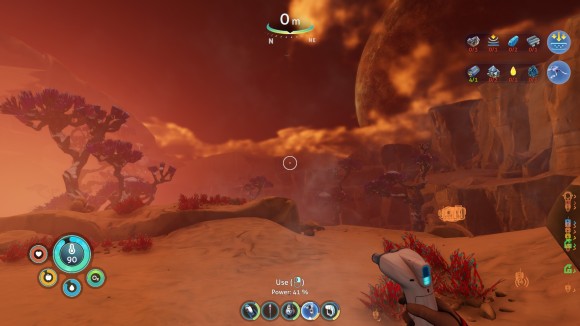
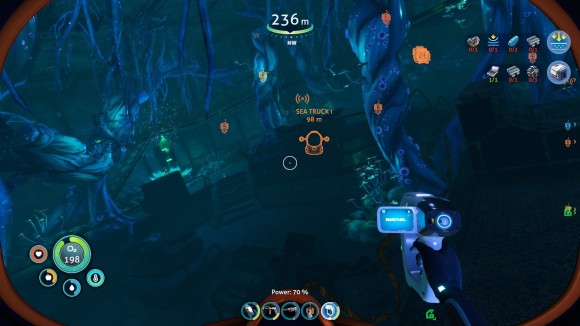
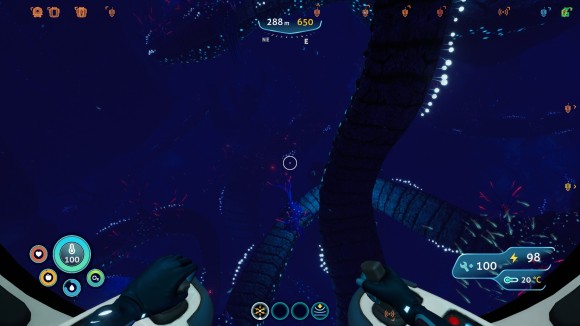
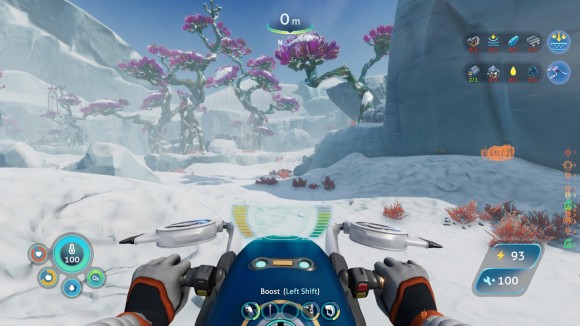
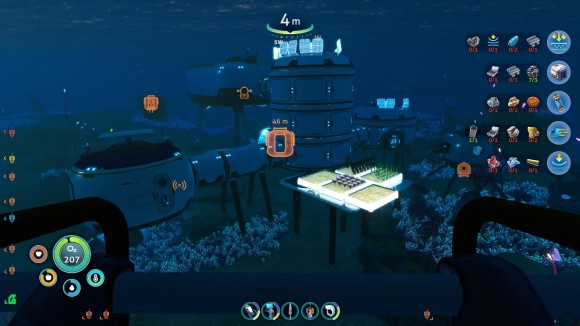
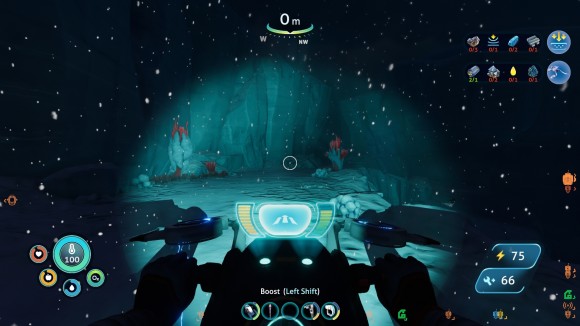
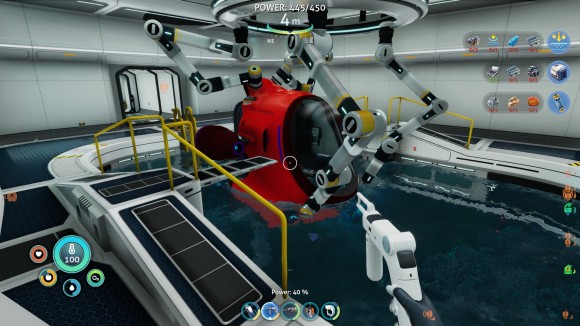
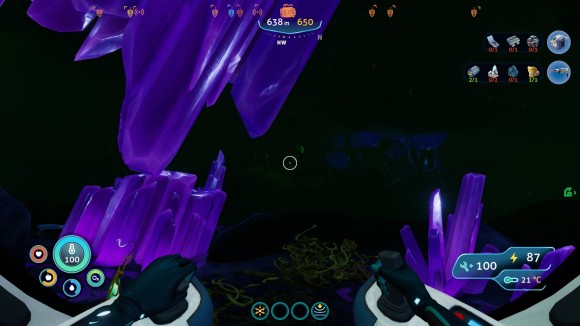
I mostly agree with your thoughts. The way the game felt more streamlined to me was mostly in how fast you’re up and running equipment wise.
I hated the new story, the part of the plot I was most interested in doesn’t really go anywhere, and the other main plot was, to me, extremely stale with an ending that hearkened to Unreal in 1998.
Your review mentions this but I was surprised at the amount of new stuff added that, in part due to how simple/short the game is, isn’t useful unless you explicitly decide to play with it. There’s a headlamp while the seaglide has a light. Many useless base rooms/equipment. Most sea truck modules are unneeded – the storage module is useful but only because they removed any standard storage. Of course it depends on where you go when, but it also seemed some powerful items were accessible too quickly, while others were only found long after they would have been useful.
I will say, though, that the prawn suit is VERY useful for on-land exploration. It might be slow but it’s the least annoying way to get around. I found the worms very annoying and, like the useless items, I’m surprised they’re in a game that should have been polished by a long period of early-access playtesting.